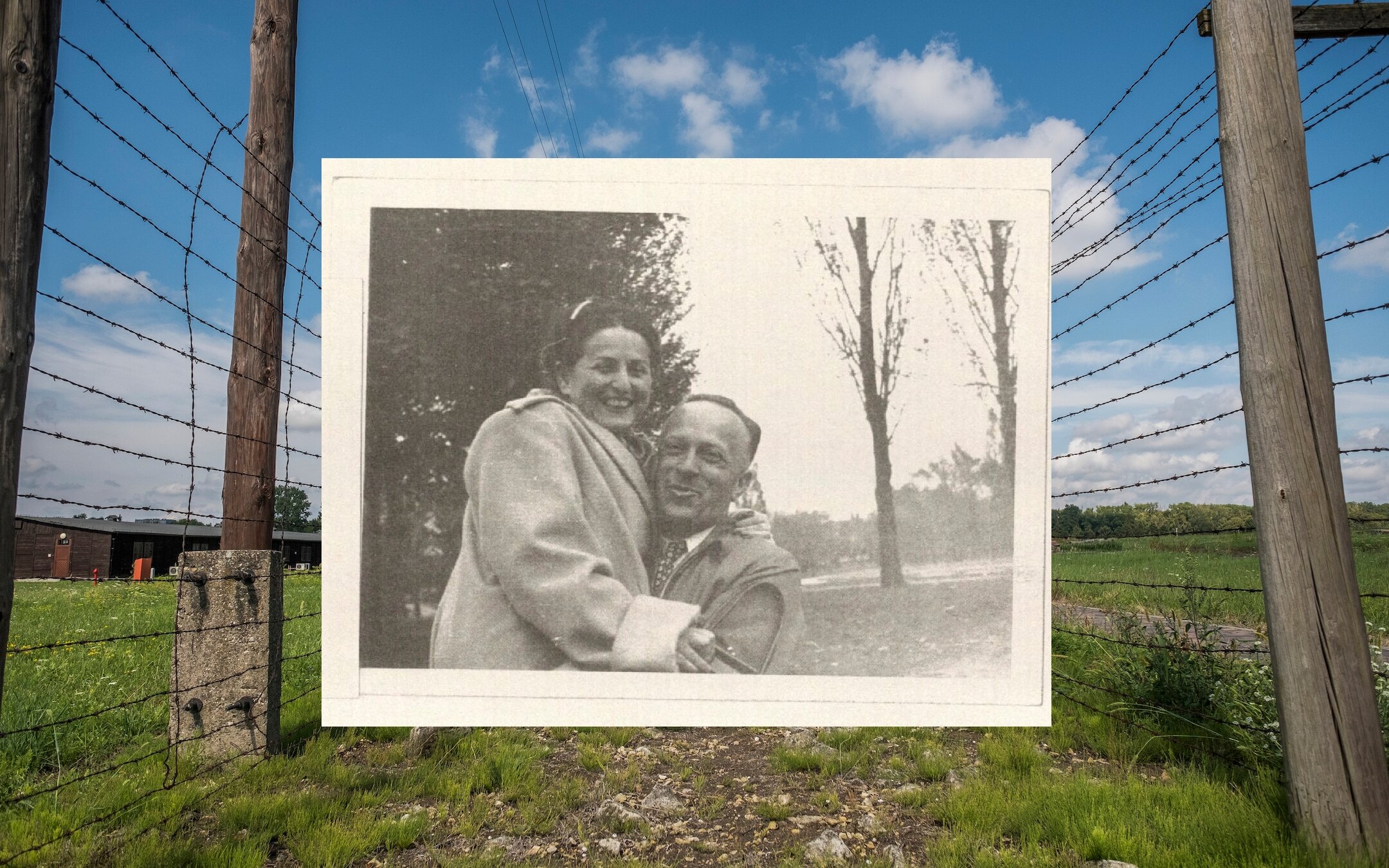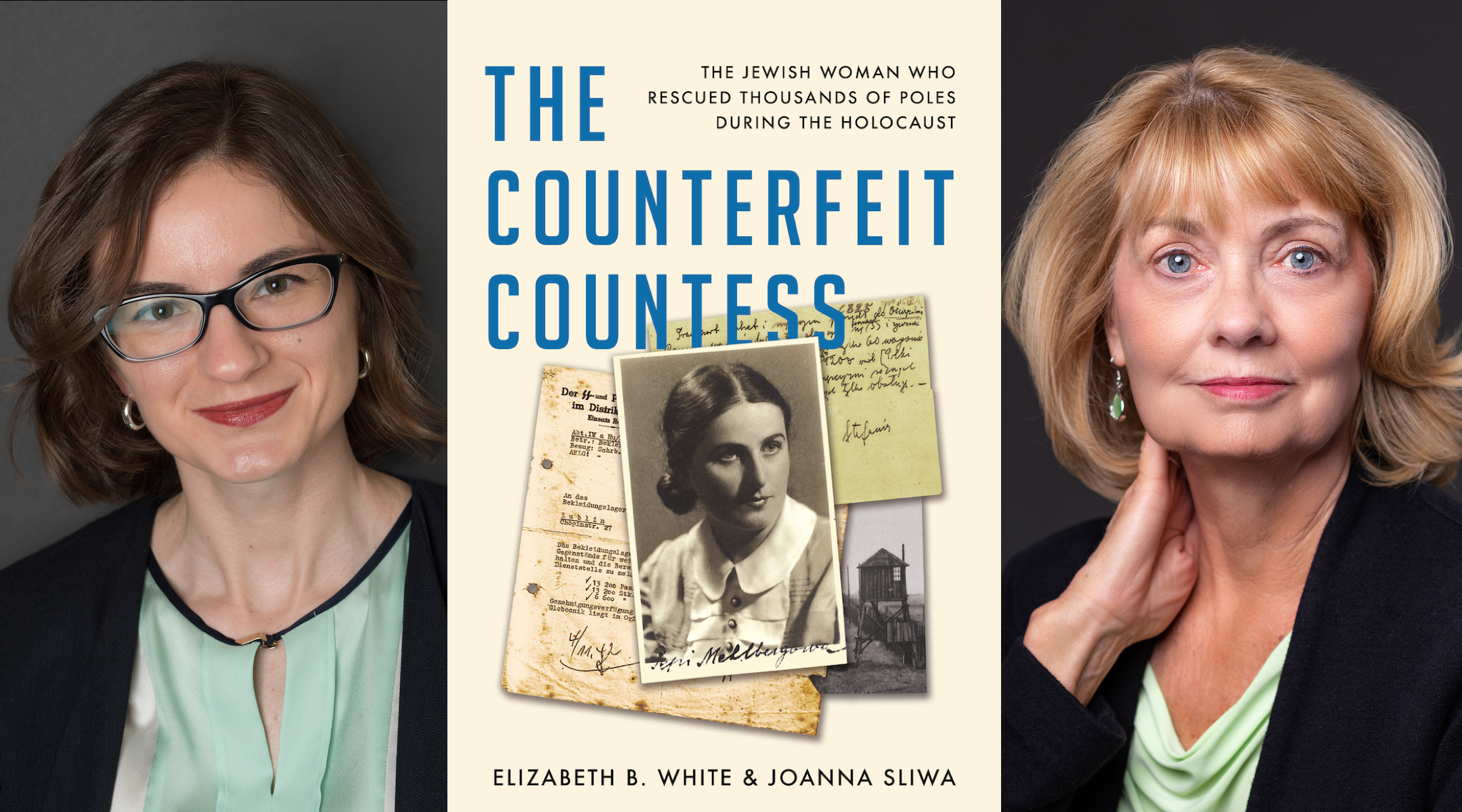A Polish ‘countess’ saved thousands of concentration camp prisoners from the Nazis. No one knew she was a Jew.
A new book tells Janina Mehlberg’s story, after three custodians of her memoirs died without seeing them published

Janina Mehlberg, seen with her husband Henry Mehlberg, was a Jewish woman who posed as a Polish countess to intervene at Majdanek, the Nazi concentration camp in Lublin, Poland, during the Holocaust. (Courtesy U.S. Holocaust Memorial Museum)
(JTA) — In December 1941, a petite, elegant woman left her home in Eastern Galicia, where she was known as the Jewish mathematician Janina Spinner Mehlberg.
Three days later, she arrived in Lublin — soon to be an epicenter of Nazi extermination in occupied Poland — with a new identity. She was now Countess Janina Suchodolska, a self-assured Polish aristocrat — and she would soon negotiate the release of thousands of prisoners from the Nazis and save thousands more through deliveries of food and medicine.
Beneath her masquerade as an aristocratic welfare official, Janina concealed that she was an officer in the underground Polish Home Army, where she in turn concealed that she was a Jew. This enigmatic character is the largely unknown heroine of “The Counterfeit Countess,” a new book by historians Elizabeth B. White and Joanna Sliwa.
Janina’s story was nearly lost to history, disclosed in an unpublished memoir that slipped through three pairs of hands before White and Sliwa embarked on corroborating it and researching their book.
After World War II, Janina and her husband Henry Mehlberg immigrated to the United States and settled in Chicago, where she taught mathematics at the Illinois Institute of Technology and he taught philosophy at the University of Chicago. She wrote her memoir shortly before her death in 1969.
Her husband translated the manuscript into English and tried unsuccessfully to publish it. Before his own death in 1979, he entrusted the package to Arthur Funk, a history professor at the University of Florida. Funk also sought in vain to interest publishers and in 1989 gave the manuscript to Barry, who had a career investigating and prosecuting Nazi criminals with the U.S. Department of Justice before serving as a historian at the United States Holocaust Memorial Museum.
“At that time, survivor memoirs and diaries were not frequently published,” Sliwa told the Jewish Telegraphic Agency. “The focus was on the perpetrators — on understanding how the Holocaust happened — and not on witnesses, because of questions about the reliability of survivor testimony.”
When Barry received the manuscript, she was a new mother busy at the DOJ, with neither the time nor the Polish language skills to conduct research in Poland. In 2007, Funk became the third custodian of Janina’s account to die without seeing it published.
Barry was haunted by a sense of responsibility and eventually connected with Sliwa, an expert on the Holocaust in Poland, forming the partnership that finally brought Janina’s story to the light of day.

Joanna Sliwa, left, and Elizabeth White together tell Janina Mehlberg’s Holocaust story in “The Counterfeit Countess,” published in January 2024. (Sliwa courtesy Claims Conference; White courtesy Erica Land Photography)
The authors supplemented Janina’s testimony with wartime documents and statements from her colleagues and former prisoners at Majdanek, the camp where she worked, along with details about her life that Janina herself did not deem important to record — such as her first 34 years.
Born Pepi Spinner in 1905, she enjoyed a privileged childhood in Żurawno (today’s Zhuravno), a town that was then Polish and is now part of Ukraine. Her father was a wealthy estate owner who socialized with Polish nobles; their children were her friends. The family experienced little overt antisemitism and Janina absorbed the Polish patriotism of her class. Along with Polish and French, she spoke German, English and Russian.
Janina’s childhood was abruptly shattered by World War I. Along with other Jewish landowners, her father was abducted by Russian forces and died in 1918. A wave of pogroms swept through Eastern Galicia after the war, killing between 100,000 and 300,000 Jews.
Still, Janina thrived as a star mathematics student at Jan Kazimierz University in Lwów (now Lviv). Despite the closed doors to both women and Jews in academia, she studied with the leading philosopher Kazimierz Twardowski and obtained a doctorate in philosophy. In 1933, she married another ambitious Jewish student of Twardowski, Henry Mehlberg.
The couple enjoyed a comfortable existence as Polish intellectuals, with him teaching philosophy in Lwów and her teaching math at a girls’ high school. But the global war soon encroached on their quiet lives. In 1939, the Soviet occupation brought hunger, totalitarianism and a war on intellectuals. Then German forces took Lwów in 1941.
With the help of Ukrainian nationalists, the Nazis immediately carried out mass shootings of Jews and prominent Polish professors, including many non-Jews who were friends of Janina and Henry. Trucks full of Jews drove daily to a hill above the city, where they were shot and buried in mass graves. Then Lwów’s Jews were ordered to move into a ghetto, which Janina and Henry knew to be a death sentence. They fled with the help of Janina’s family friend, Count Andrzej Skrzyński, who promised to procure them false papers, jobs and a place to live in Lublin.
Transformed into Count Piotr Suchodolski, Henry got an agricultural job that allowed him to keep a low profile. But Janina — now Countess Suchodolska — was not content to evade death narrowly. Instead, White and Sliwa said that she followed one mathematical principle: “The value of one life is less than the value of multiple lives, and her life, if she survived without seeking to save others, would have no value.”

Janina Mehlberg poses with her fellow students of Kazimierz Twardowski at Jan Kazimierz University in Lwów, 1925 or 1926. (Courtesy Jan Woleński)
Janina joined the Polish Main Welfare Council (known by its Polish initials RGO), the only Polish civil society organization allowed to operate under the Nazi government. While working undercover for the Polish resistance, Janina walked into Majdanek several days a week to meet with mass murderers and argue that saving a certain number of Polish lives would serve their interests.
“The Counterfeit Countess” details how Janina’s mathematical mind gave her insight into Nazi Germany’s calculations of life and death. She took advantage of a shift in the war, when the Nazis realized they would not conquer the Soviet Union as quickly as they had hoped. By February 1943, Russian forces had crushed the Germans at Stalingrad and Allied bombs were incinerating German cities.
“They needed to have foreign workers replace all the German men who had to go to the front,” said White. “Heinrich Himmler wanted to develop his concentration camps as reservoirs of forced labor, and he ordered thousands of Poles be sent to the camps — especially Majdanek and Auschwitz.”
The concentration camps were not designed for productive labor, but for mass death: Many of the prisoners who were not immediately murdered died from starvation, exhaustion or disease. But if Himmler’s underlings wanted to profit the Reich, they needed more prisoners who actually survived to continue working — ideally through an organization that fed them without SS spending.
Janina used this bargaining chip to deliver increasing amounts of food and clothes to Polish inmates of Majdanek. When typhus raged through the camp, defying quarantines and even spreading to German soldiers, she negotiated the provision of medicines. On top of her authorized deliveries, she smuggled more food and messages from the Polish resistance.

A memorial at the entrance to the Majdanek concentration camp near Lublin, Poland. (Alians PL)
She also pushed for the release of Polish inmates who were rated unfit to work, such as the sick, orphaned children and disabled detainees, to the care of the RGO. In total, White and Sliwa documented that Janina negotiated the release of at least 9,707 Poles, including 4,431 from Majdanek.
The RGO could solely aid those considered racially Polish by the Germans — so Janina’s efforts could not be directed toward her fellow Jews. And no mathematical gymnastics could help her against the killing machine meant for her people. Within Nazi race ideology, Jews were the most dangerous of Germany’s “subhuman” enemies and had to disappear from the “Lebensraum” (“living space”) Hitler intended to conquer for the German people. A minority of ethnic Poles, who ranked slightly higher on the subhuman scale, would be allowed to survive as laborers for their German masters.
That meant that even within the Polish Home Army, Janina had to keep her Jewish identity secret. Members of the underground ranged from friends of Jews, such as Count Skrzyński, to right-wing nationalists who wanted no Jews in their ranks.
Her efforts to help Jews were solitary and confined to the margins of her bureaucratic labor. She knew that Jews lived together with Poles at Majdanek and that each compound’s kitchen fed prisoners from the same cauldrons. As she strove to deliver more and more food into the camp, she held onto hope that it would enrich soup fed to all the prisoners, staving off starvation for thousands of Jews alongside Poles.
But on one visit to Majdanek in May 1943, she smelled the burning flesh of the last Jews from the Warsaw Ghetto, who were sent to be gassed by the thousands after the Warsaw Ghetto Uprising. She also saw 30,000 Lublin Jews deported to the Bełżec death camp — a crucial component of Operation Reinhard, Germany’s Final Solution to murder all the Jews in Poland.
One and a half million Jews were murdered at the killing centers of Bełżec, Sobibór and Treblinka as part of Operation Reinhard. Janina was one of the first Poles to learn how the operation ended, with 42,000 Jews shot at Majdanek, Trawniki and Poniatowa on Nov. 3 and 4, 1943. It was the largest German mass shooting of the Holocaust, code-named Operation Harvest Festival by the Nazis.
In her memoir, Janina never described how she, a Jew in disguise, was affected by witnessing the slaughter of Jews. That might be because she intended her book for a Polish audience in the 1960s, when antisemitic narratives about the Holocaust were prevalent in the Soviet Union, said White and Sliwa.
She also considered herself, according to her own accounts, as much a Pole as she was a Jew. She and Henry were not religious, although they would partake in secular Jewish communal activities in Toronto and Chicago after the war.
Notwithstanding the Nazi-imposed racial hierarchy, many Polish Jews did not feel they had to choose between two identities in the 1930s. Only a minority of them were religious, according to Judy Batalion, who researched Jewish women in Poland’s resistance for her 2021 book, “The Light of Days: The Untold Story of Women Resistance Fighters in Hitler’s Ghettos.”
“They were fully Polish. Many of these women had a lot of questions about their position in Polish society in the Second Republic but they were Polish.” said Battalion, using a term for the Polish state during the interwar period,
Though she was never religious, Janina ended her memoir with a gesture toward both her Jewish faith as Janina Mehlberg and her Christian one as the Countess Suchodolska. In this final chapter, excerpted at the end of “The Counterfeit Countess,” she described taking a tour of Majdanek with a Swedish delegation after it was liberated. The ever-pragmatic mathematician, who lived by the principle of maximizing the number of lives saved, then considered all of the people for whom such calculations were no solace.
“I thought of those who had been broken, physically and morally, who had betrayed other lives in the hope of saving their own,” she said. “However we risked our necks, it was of our own will. But they were in bondage, and all human pride was beaten out of them. They didn’t ask to be martyrs. Most of them no doubt wanted nothing more than to live out their days in an average, humdrum existence, without great impact and without glory.”
For those souls, Janina turned momentarily from mathematics to prayer, perhaps finding her sorrow too great for the world of the living.
“There is nothing left to do for them but to remember,” she wrote. “And in the way of my ancestors, intone ‘Yisgadal, v’yiskadash,’ the Kaddish for the dead, and like the real Countess Suchodolska, ‘Kyrie Eleison, Christe Eleison,’” its Christian equivalent.
This article originally appeared on JTA.org.
A message from our Publisher & CEO Rachel Fishman Feddersen

I hope you appreciated this article. Before you go, I’d like to ask you to please support the Forward’s award-winning, nonprofit journalism so that we can be prepared for whatever news 2025 brings.
At a time when other newsrooms are closing or cutting back, the Forward has removed its paywall and invested additional resources to report on the ground from Israel and around the U.S. on the impact of the war, rising antisemitism and polarized discourse.
Readers like you make it all possible. Support our work by becoming a Forward Member and connect with our journalism and your community.
— Rachel Fishman Feddersen, Publisher and CEO





























